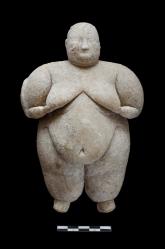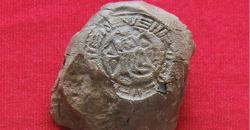INSTITUT SUPERIEUR D'ANTHROPOLOGIE
INSTITUTE OF ANTHROPOLOGY
ONLINE COURSES / COURS A DISTANCE
FALL TERM : OCTOBER 2016
REGISTER NOW
TURQUIE –  Çatalhöyük - Archaeologists at Turkey's neolithic site of Çatalhöyük in central Anatolia have unearthed a "unique" complete female figurine, The Ministry of Culture and Tourism said on Tuesday. The statuette, measuring 17 centimeters (6.7 inches) long and weighing one kilogram (2.2 pounds), is considered unique due to its intact form and fine craftsmanship; it dates back to about 5500-8000 BC, a statement said. The figurine, which is made of marmoreal stone and considered to be part of a ritual, was discovered by the international team of archaeologists working on site led by Professor Ian Hodder, anthropologist at Stanford University in the U.S. One of the world's first urban centers which dates back 9,000 years, Çatalhöyük is included in the 2012 UNESCO World Heritage List.
Çatalhöyük - Archaeologists at Turkey's neolithic site of Çatalhöyük in central Anatolia have unearthed a "unique" complete female figurine, The Ministry of Culture and Tourism said on Tuesday. The statuette, measuring 17 centimeters (6.7 inches) long and weighing one kilogram (2.2 pounds), is considered unique due to its intact form and fine craftsmanship; it dates back to about 5500-8000 BC, a statement said. The figurine, which is made of marmoreal stone and considered to be part of a ritual, was discovered by the international team of archaeologists working on site led by Professor Ian Hodder, anthropologist at Stanford University in the U.S. One of the world's first urban centers which dates back 9,000 years, Çatalhöyük is included in the 2012 UNESCO World Heritage List.
http://www.dailysabah.com/history/2016/09/13/neolithic-figurine-over-7000-years-old-unearthed-at-turkeys-catalhoyuk
CHYPRE –  Kourion - Archaeologists working at Kourion in Limassol this year have established that a large building being excavated, which looks to have collapsed during a massive earthquake in the 4th century AD, could either have been an elite residence or a public building. Its full size, construction and history remain unknown, however, the department said. The building may have been two stories high, the statement said, adding that the floor plan was not yet complete and was awaiting further investigation.“Massive blocks thrown down by the earthquake cover the floors of the building. The power of the tremor is indicated by the distortions of the walls and the movement of the heavy ashlar masonry,” it added. The collapsed house was also found to be rich in material cultural remains. The team recovered additional fragments of a large imported glass plate 60cm-plus in diameter, that had been discovered in 2014. The plate was formed from bundles of hollow yellow glass canes which were fused together in a dark green matrix. The plates were crafted in Egypt, and are usually found in Coptic cemeteries. Additional Egyptian connections were suggested by the presence of a restorable amphora of Egyptian style, recovered from near the floor of what the team interpreted to be a kitchen area. “The wealth of this ancient household is indicated by a large elegant room with a mosaic floor, marble panelling and painted wall plaster,” it said. Ceramic analysis by the KUSP team, including Dr Scott Moore of Indiana University, Pennsylvania, indicated a mid-4th century date for the tragedy.
Kourion - Archaeologists working at Kourion in Limassol this year have established that a large building being excavated, which looks to have collapsed during a massive earthquake in the 4th century AD, could either have been an elite residence or a public building. Its full size, construction and history remain unknown, however, the department said. The building may have been two stories high, the statement said, adding that the floor plan was not yet complete and was awaiting further investigation.“Massive blocks thrown down by the earthquake cover the floors of the building. The power of the tremor is indicated by the distortions of the walls and the movement of the heavy ashlar masonry,” it added. The collapsed house was also found to be rich in material cultural remains. The team recovered additional fragments of a large imported glass plate 60cm-plus in diameter, that had been discovered in 2014. The plate was formed from bundles of hollow yellow glass canes which were fused together in a dark green matrix. The plates were crafted in Egypt, and are usually found in Coptic cemeteries. Additional Egyptian connections were suggested by the presence of a restorable amphora of Egyptian style, recovered from near the floor of what the team interpreted to be a kitchen area. “The wealth of this ancient household is indicated by a large elegant room with a mosaic floor, marble panelling and painted wall plaster,” it said. Ceramic analysis by the KUSP team, including Dr Scott Moore of Indiana University, Pennsylvania, indicated a mid-4th century date for the tragedy.
http://cyprus-mail.com/2016/09/13/kourion-plate-best-example-world/
ROYAUME UNI –  Plymouth - Sherford may be a new town on the eastern edge of Plymouth, but it has a rich history going back thousands of years, archaeologists have found. Among the items found are a rare decorated bone weaving comb, Roman pottery and coins. A team from Wessex Archaeology was brought in by the Sherford Consortium, and found roundhouses, which functioned as homes for large family groups in prehistoric farming communities. The excavation also revealed two Early Bronze Age (2400-1600 BC) burial mounds (also known as barrows), with one containing the cremated remains of an individual, likely of high importance, in a decorated pottery vessel. The two burial sites appear to have been sacred ground for more than 2,000 years.
Plymouth - Sherford may be a new town on the eastern edge of Plymouth, but it has a rich history going back thousands of years, archaeologists have found. Among the items found are a rare decorated bone weaving comb, Roman pottery and coins. A team from Wessex Archaeology was brought in by the Sherford Consortium, and found roundhouses, which functioned as homes for large family groups in prehistoric farming communities. The excavation also revealed two Early Bronze Age (2400-1600 BC) burial mounds (also known as barrows), with one containing the cremated remains of an individual, likely of high importance, in a decorated pottery vessel. The two burial sites appear to have been sacred ground for more than 2,000 years.
http://www.plymouthherald.co.uk/ancient-coins-pottery-and-bone-comb-found-at-building-site/story-29710510-detail/story.html
TURQUIE –  Tatarlı Mound - Excavations at Tatarlı Mound in the southern province of Adana’s Ceyhan district have unearthed an impression seal from a monumental Hittite-era structure. The seal contains information from about 3,000 years ago. The female name “Pati” was also found on the seal. Tatarlı Mound excavations deputy head Serdar Girginer said the seal might have been from the period of famous Queen Puduhepa, and continued: “Both archaeological and interdisciplinary research at Tatarlı Mound always provides data giving holy messages. These findings like impression seals reveal that it was a very important city. In 2008 we found another seal reading the name of a Hittite person... now this seal has a name, too. This person is from the time of Puduhepa in a later period.” Çukurova University academic Meltem Doğan Alparslan said a similar seal was found in Ras Shamra in Syria. She said that other examples of the seal were also unearthed in the Hattusha excavations, adding, “This seal makes us think that a woman named Pati was an important person in the region.”
Tatarlı Mound - Excavations at Tatarlı Mound in the southern province of Adana’s Ceyhan district have unearthed an impression seal from a monumental Hittite-era structure. The seal contains information from about 3,000 years ago. The female name “Pati” was also found on the seal. Tatarlı Mound excavations deputy head Serdar Girginer said the seal might have been from the period of famous Queen Puduhepa, and continued: “Both archaeological and interdisciplinary research at Tatarlı Mound always provides data giving holy messages. These findings like impression seals reveal that it was a very important city. In 2008 we found another seal reading the name of a Hittite person... now this seal has a name, too. This person is from the time of Puduhepa in a later period.” Çukurova University academic Meltem Doğan Alparslan said a similar seal was found in Ras Shamra in Syria. She said that other examples of the seal were also unearthed in the Hattusha excavations, adding, “This seal makes us think that a woman named Pati was an important person in the region.”
http://www.hurriyetdailynews.com/ancient-seal-found-in-tatarli-mound-.aspx?pageID=238&nID=103834&NewsCatID=375
CANADA –  Terror Bay - Deux ans à peine après avoir découvert le HMS Erebus,navire perdu de la désastreuse expédition du britannique John Franklin, il y a 168 ans, le HMS Terror, le second bâtiment recherché, vient d’être à son tour retrouvé par les équipes de Parcs Canada à… Terror Bay, dans le territoire du Nunavut, au Canada. Soit à 96 km au sud de l’endroit où le bateau était supposé avoir été écrasé par les glaces. Selon le quotidien britanniqueThe Guardian à qui l’on doit ces informations exclusives, l’épave du HMS Terror git en parfait état au fond des eaux glacées de l’Arctique. Les deux navires partis de Grande-Bretagne en mai 1845 à la recherche du célèbre « passage du Nord-ouest », une nouvelle voie maritime permettant de relier directement l’océan Atlantique au Pacifique, avaient dû être abandonnés par leurs équipages en 1848, après trois ans de navigation. Ce qui avait entraîné la disparition de la totalité des 129 hommes embarqués, tous morts dans des conditions atroces de faim et de froid.
Terror Bay - Deux ans à peine après avoir découvert le HMS Erebus,navire perdu de la désastreuse expédition du britannique John Franklin, il y a 168 ans, le HMS Terror, le second bâtiment recherché, vient d’être à son tour retrouvé par les équipes de Parcs Canada à… Terror Bay, dans le territoire du Nunavut, au Canada. Soit à 96 km au sud de l’endroit où le bateau était supposé avoir été écrasé par les glaces. Selon le quotidien britanniqueThe Guardian à qui l’on doit ces informations exclusives, l’épave du HMS Terror git en parfait état au fond des eaux glacées de l’Arctique. Les deux navires partis de Grande-Bretagne en mai 1845 à la recherche du célèbre « passage du Nord-ouest », une nouvelle voie maritime permettant de relier directement l’océan Atlantique au Pacifique, avaient dû être abandonnés par leurs équipages en 1848, après trois ans de navigation. Ce qui avait entraîné la disparition de la totalité des 129 hommes embarqués, tous morts dans des conditions atroces de faim et de froid.
http://www.sciencesetavenir.fr/archeo-paleo/archeologie/20160913.OBS7923/expedition-franklin-on-a-retrouve-le-hms-terror.html
FRANCE – Pontivy - Entamées le 20 juin dernier, en même temps que les travaux de reconstruction de la courtine sud, les fouilles préventives du Château des Rohan, réalisées par le service archéologie du département du Morbihan, ont déjà révélé la présence de deux fours anciens, dont la chronologie n'est pas encore établie. "En 1990, des archéologues avaient déjà anticipé la présence d'un petit four à pâtisserie, et avaient décidé de sonder la partie Ouest de la courtine. Mais c'est sur la partie Est que nous avons découvert, de manière inattendue, un deuxième four, bien plus gros que le premier puisqu'il possède un diamètre interne d'1,80 m", explique Karine Vincent, archéologue spécialisée en Moyen-Âge au département du Morbihan. D'une hauteur de près de 5 m, ce four à pain de granit "est très bien conservé et a beaucoup servi. En témoignent les pierres roses et rouges en son cœur". Les deux fours ont fait l'objet d'un scan en trois dimensions, effectué ce lundi par la société de géomètres experts Fit Conseil, de Nantes.
VIDEO = http://www.dailymotion.com/video/x4sy42x_pontivy-chateau-des-rohan-les-fouilles-revelent-deux-anciens-fours_news
http://www.letelegramme.fr/morbihan/pontivy/chateau-des-rohan-les-fouilles-revelent-deux-anciens-fours-12-09-2016-11214516.php#closePopUp